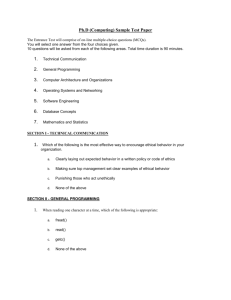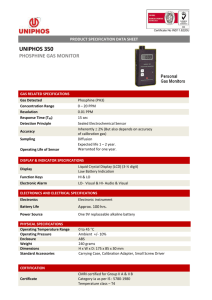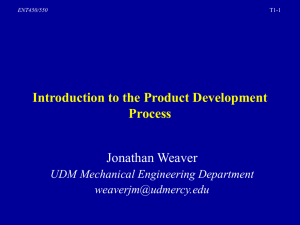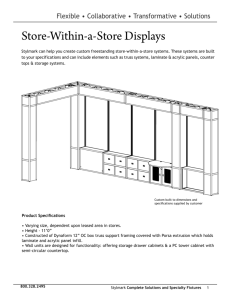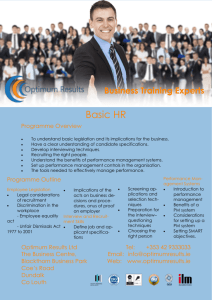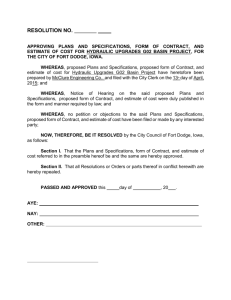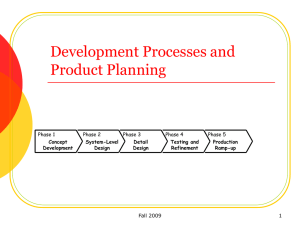Chapter 2
advertisement
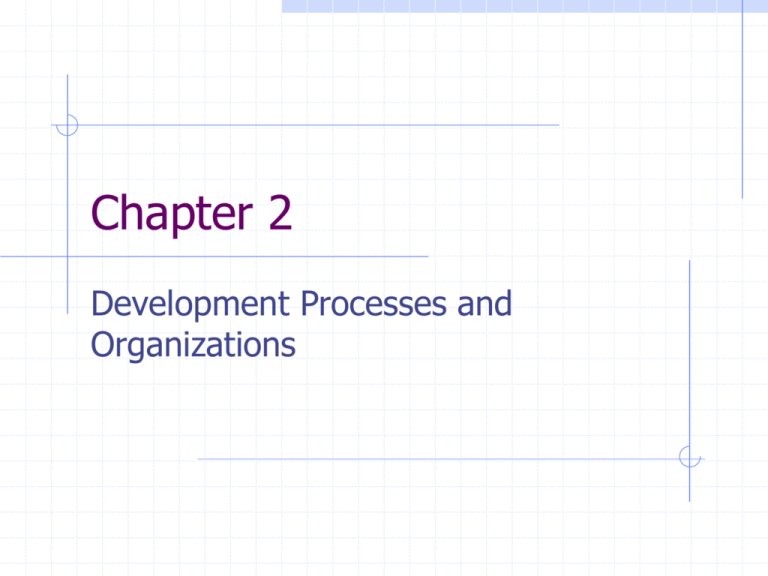
Chapter 2 Development Processes and Organizations Learning Objectives Is there a standard development process that will work for every company? What role do experts from different functional areas play in the development process? What milestones can be used to divide the overall development process into phases? Should the development organization be divided into groups corresponding to projects or to development functions? Usefulness of a well-defined Development Process Quality assurance Coordination Planning Performance Management Improvement Six Phases of the Generic Development Process 1. 2. 3. 4. 5. 6. Planning Concept development System-Level design Detail design Testing and refinement Production ramp-up Planning Often referred to as “phase zero” since it precedes the project approval and launch of the actual product development process. Output: Target market, business goals, key assumptions and constraints. Concept Development Needs of the target market are identified, alternative products concepts are generated and evaluated, and one more concepts are selected for further development and testing. System-level Design Includes the definition of the product architecture and the decomposition of the product into subsystems and components. The final assembly scheme for the production system is usually defined during this phase. Detail Design Includes complete product specifications such as tolerances, materials, geometry, etc. Specifications of the purchased parts Process plans and assembly plans of the product defined Tooling defined Testing and Refinement Involves construction and evaluation of several preproduction versions of the product Early (alpha) prototypes: Usually built with production-intent parts -- parts with the same geometry and material properties as the production version but not necessarily fabricated with the actual processes to be used in production. Alpha prototypes tested to determine whether (a) the product will work as designed and (b) product satisfies key customer needs. Testing and Refinement Beta prototypes are usually built with parts supplied by the intended production processes but may not be assembled using the intended final assembly process. Beta prototypes used to answer questions about performance and reliability in order to identify necessary engineering changes. Production ramp-up The product is made using the intended production system. Purpose is to train the work force and weed out any remaining problems in the production processes Transition from ramp-up to normal production is gradual The Generic Product Development Process Concept Development Activities Identifying customer needs Establishing target specifications Concept generation Concept selection Concept testing Setting final specifications Project planning Economic analysis Benchmarking of competitive products Modeling and prototyping Identifying customer needs The goal of this activity is to understand customers’ needs and to effectively communicate them to the development team. Output: organized customer needs list, importance rating for each need Establishing target specifications Specifications provide a precise description of what a product has to do. They are translation of the customer needs into technical terms. Targets for the specifications are set early in the process and represent the hopes of the development team. Concept generation The goal is to thoroughly explore the space of product concepts that may address the customer needs Concept generation includes a mix of internal and external search Output: Usually a set of 10-20 concepts, each typically represented by a sketch and brief descriptive text Concept selection Concept selection is the activity in which various product concepts are analyzed and sequentially eliminated to identify the most promising concept(s). Concept testing One or more concepts are tested to verify that the customer needs have been met, assess the market potential of the product, and identify any shortcomings. Setting final specifications The target specifications set earlier in the process are revisited after a concept has been selected and tested. Project planning The team creates a detailed development schedule, devises a strategy to minimize development time, and identifies the resources required to complete the project. Major results of the front-end activities are captured in a contract book which contains the mission statement, the customer needs, the detail of the selected concept, the product specifications, the economic analysis of the product, the development schedule, the project staffing, and the budget. Economic analysis The team often with the support of a financial analyst, builds an economic model for the new product. This model is used to justify continuation of the overall development program and to resolve specific tradeoff among, for example, development costs and manufacturing costs. Benchmarking of competitive products An understanding of competitive products is critical to successful positioning of a new product and can provide a rich source of ideas for the product and production process design. Modeling and prototyping Every stage of the concept development process involves various forms of models and prototypes. These may include, among others: early “proof-of-concept” models, which help the development team to demonstrate feasibility: “form-only” models, which can be shown to customers to evaluate ergonomics and style; and spreadsheet models of technical trade-offs. Adapting the Generic Product Development Process Technology-push product Platform products Process-intensive products Customized products Technology-Push Products The firm begins with a new proprietary technology and looks for an appropriate market in which to apply this technology Gore-Tex (an expanded Teflon sheet) manufactured by W.L. Gore Associates Technology-Push Products Many extremely successful products have arisen from technology-push development This approach is unlikely to succeed unless - the assumed technology offers a clear competitive advantage - suitable alternative technologies are unavailable or very difficult for competitors to utilize. Platform Products A platform product is built around a preexisting technological subsystem ( a Technology Platform). Examples: tape transport mechanism in the Sony Walkman, the Apple Macintosh OS Huge investments were made in developing these platforms, and therefore every attempt is made to incorporate them into several different products. Platform Products Differences between Technology Push & Platform products: a technology platform has already demonstrated its usefulness in the marketplace in meeting customer needs Products built on technology platforms are much simpler to develop than if the technology were developed from scratch. Process Intensive Products Examples of process-intensive products include semiconductors, foods, chemicals, and paper. In many cases, process-intensive products are produced in very high volumes and are bulk, as opposed to discrete goods. Customized Products Examples: switches, motors, batteries, and containers. Slight variations of standard configurations and typically developed in response to a specific order by a customer. Development of customized products consists primarily of setting values of design variables such as physical dimensions. Variants of Generic Development Process Product Development Organizations Organizations are formed by establishing formal or informal links among individuals Reporting relationships: Reporting relationships give rise to the classic notion of supervisor and subordinate. Financial arrangements: Individuals are linked by being part of the same financial entity, such as that defined by a particular budget category or profit-and-loss statement. Physical Layout: links are created between individuals when they share the same office, floor, building, or site. Product Development Organizations Regardless of their organizational links, particular individuals can be classified in two different ways: according to their function and according to the projects they work on. Product Development Organizations A function (in organizational terms) is an area of responsibility usually involving specialized education, training, or experience. Regardless of their functions, individuals apply their expertise to specific projects. In product development, a project is the set of activities in the development process for a particular product. Functional & Project Organizations In functional organizations, the organizational links are primarily among those who perform similar functions. In project organizations, the organizational links are primarily among those who work on the same project. Matrix Organizations The matrix organization was conceived as a hybrid of functional and project organizations. In the matrix organization, individuals are linked to others according to both the project they work on and their function. Typically each individual has two supervisors, one a project manager and one a functional manager. Variants of the matrix organization Heavyweight project organization Lightweight project organization. A heavy weight project organization contains strong project links. Various Product Development Organizations Choosing an Organizational Structure The most appropriate choice of organizational structure depends on which organizational performance factors are most critical to success. Functional organizations tend to breed specialization and deep expertise in the functional areas. Project organizations tend to enable rapid and effective coordination among diverse functions. Choosing an Organizational Structure How important is cross-functional integration? How critical is cutting-edge functional expertise to business success? Can individuals from each function be fully utilized for most of the duration of a project? How important is product development speed? Characteristics of Different Organizational Structure

